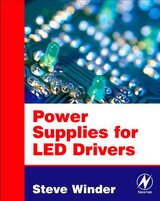 |
Облако тегов |
 |
 |
Arduino, Circuit Cellar, Elektor, Everyday Practical Electronics, Nuts and Volts, Raspberry Pi, антенна, аудио, видео, Журнал, Измерения, Микроконтроллеры, Микросхемы, микроэлектроника, Программирование, Радіоаматор, Радио, Радио (жур.), Радиоаматор, Радиоконструктор, Радиолюбитель, радиолюбителю, Радиомир, радиосвязь, радиоэлектроника, ремонт, Ремонт и Сервис, робототехника, Связь, Серия Ремонт, справочник, схема, Схемотехника, Схемы, Телевидение, Телевизоры, усилитель, Электрик, Электроника, Электротехника
Показать все теги
|
 |
 |
 |
 |
 |
Авторские права |  |
 |
Все книги на сайте представлены исключительно в ознакомительных целях!
Авторам, желающим внести поправки, просим связаться с администрацией.
Администрация
|
 |
 |
 |
 |
|
 |
 |
Книги » Электроника: Power Supplies for LED Driving
|
 |
 |
 Просмотров: 2063 Просмотров: 2063  добавил: Nikey добавил: Nikey  19-12-2010, 10:59 19-12-2010, 10:59 
|
|

Название: Power Supplies for LED Driving
Автор: Steve Winder
Издательство: Newnes
Год: 2008
Страниц: 248
Язык: Английский
|
|
Light-emitting diodes are being widely used due to their efficient use of power. The applications for power LEDs include traffic lights, street lamps, automotive lighting, architectural lights, household light replacements, signage lighting (replacing neon strip lights and fluorescent tubes), and many more.
Powering (driving) these LED's is not always simple. Linear driving is inefficient and generates far too much heat. With a switching supply, the main issues are EMI and efficiency, and of course cost. The problem is to get a design that meets legal requirements and is efficient, while costing the least. This book covers the design trade-offs involved in LED driving applications, from low-power to UB-LEDs and beyond.
* Practical, "hands-on" approach to power supply design for LED drivers;
* Detailed examples of what works and why, throughout the design process;
* Commentary on how the calculated component value compares with the actual value used, including a description of why the choice was made.
Table of contents:
Preface
Chapter 1: Introduction
1.1 Objectives and General Approach
1.2 Description of Contents
Chapter 2: Characteristics of LEDs
2.1 Applications for LEDs
2.2 Light Measure
2.3 Equivalent Circuit to an LED
2.4 Voltage Drop Versus Color and Current
2.5 Common Mistakes
Chapter 3: Driving LEDs
3.1 Voltage Source
3.2 Current Source
3.3 Testing LED Drivers
3.4 Common Mistakes
3.5 Conclusions
Chapter 4: Linear Power Supplies
4.1 Introduction
4.2 Advantages and Disadvantages
4.3 Limitations
4.4 Common Errors in Designing Linear LED Drivers
Chapter 5: Buck-Based LED Drivers
5.1 An Example Buck Converter Control IС
5.2 Buck Circuits for DC Applications
5.3 Buck Circuits for AC Input
5.4 Buck Circuits Powered by an AC Phase Dimmer
5.5 Common Errors in AC Input Buck Circuits
5.6 Double Buck
5.7 Hysteretic Buck
Chapter 6: Boost Converters
6.1 Boost Converter Operating Modes
6.2 H V9912 Boost Controller
6.3 Design of a Continuous Conduction Mode Boost LED Driver
6.4 Design of a Discontinuous Conduction Mode Boost LED Driver
6.5 Common Mistakes
6.6 Conclusions
Chapter 7: Boost-Buck Converter
7.1 The Cuk Converter
7.2 SEPIC Buck-Boost Converters
7.3 Buck-Boost Topology
7.4 Common Mistakes in Boost-Buck Circuits
7.5 Conclusions
Chapter 8: LED Drivers with Power Factor Correction
8.1 Power Factor Correction
8.2 Bi-Brcd
8.3 Buck-Boost-Buck (BBB)
8.4 Common Mistakes with PFC Circuits
8.5 Conclusions
Chapter 9: Fly-Back Converters
9.1 Two Winding Fly-Back
9.2 Three Winding Fly-Back
9.3 Single Winding Fly-Back (Buck-Boost)
Chapter 10: Essentials of Switching Power Supplies
10.1 Linear Regulators
10.2 Switching Regulators
Chapter 11: Selecting Components for LED Drivers
11.1 Discrete Semiconductors
11.2 Passive Components
11.3 The Printed Circuit Board (PCB)
11.4 Operational Amplifiers and Comparators
Chapter 12: Magnetic Materials for Inductors and Transformers
12.1 Ferrite Cores
12.2 Iron Dust Cores
12.3 Special Cores
12.4 Core Shapes and Sizes
12.5 Magnetic Saturation
12.6 Copper Losses
Chapter 13: EMI and EMC Issues
13.1 EMI Standards
13.2 Good EMI Design Techniques
13.3 EMC Standards
13.4 EMC Practices
Chapter 14: Thermal Considerations
14.1 Efficiency and Power Loss
14.2 Calculating Temperature
14.3 Handling Heat - Cooling Techniques
Chapter 15: Safety Issues
15.1 AC Mains Isolation
15.2 Circuit Breakers
15.3 Creepage Distance
15.4 Capacitor Ratings
15.5 Low Voltage Operation
Bibliography
Index
Author Biography
|
|
Содержание  Оглавление Оглавление
|
|
|
|
|
|
|
|
Другие новости по теме:
|
|
|
|
 |
 |
|
 |
|
 |
Информация |
 |
 |
 |
Посетители, находящиеся в группе Гости, не могут оставлять комментарии к данной публикации. |
 |
 |
 |
 |
|
 |
 |
Календарь |
 |
 |
|
« Октябрь 2020 »
|
| Пн |
Вт |
Ср |
Чт |
Пт |
Сб |
Вс |
| |
1
|
2
|
3
|
4
|
|
5
|
6
|
7
|
8
|
9
|
10
|
11
|
|
12
|
13
|
14
|
15
|
16
|
17
|
18
|
|
19
|
20
|
21
|
22
|
23
|
24
|
25
|
|
26
|
27
|
28
|
29
|
30
|
31
|
|
|
 |
 |
 |
 |
|

